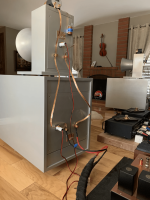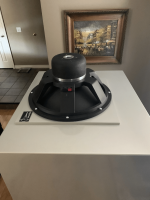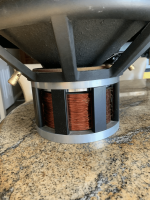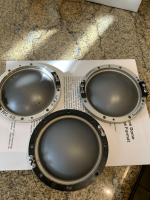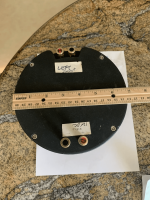No, unfortunately not, but I really appreciate his contributions to the audio world, as any audio freak should.Yes have you ever heard one of Bruce Edgars Titan systems?? Got to hear his set-up with his Seismic sub! They were stunning and effortless. No honk at all,
Rob
This is Bruce's legacy at the stratospheric level:
Attachments
Although the Titan system above can be labeled as 'room friendly', I personally tend to prefer a full-range 2-way system, wherein bass-midrange issues are overcome by extra cone surface.
That's why Bert Doppenberg's Orelo is still playing on my mind, but with a cloth cover stretched over the back panel to dampen the back wave somewhat.
This idea is inspired by the bass cabinet of the G.I.P. 9700A, in which fabric slats are used.

That's why Bert Doppenberg's Orelo is still playing on my mind, but with a cloth cover stretched over the back panel to dampen the back wave somewhat.
This idea is inspired by the bass cabinet of the G.I.P. 9700A, in which fabric slats are used.
Last edited:
The lower end of this sweep reminded me of Joseph Crowe's latest video at the section where he talks about mouth expansion rate.My elliptical tractrix horn cutoff is near that...above cutoff there is the amplitude modulation I described; a peak at ~170hz and ~290hz.... with about +\- 3 to 4db through the median....
Sure look high Q to me.Getting into perception....Are not those peaks leaning towards the high Q side? Are not lower Q filters much more potent in affecting perception of tone?
I definitely do not experience a sense of delayed arrival....but as I learned....the start up transient....starts on time. Really only an issue of transient part of the signal.
Depends, I mean peaks is our 'fight or flight' trigger, but down this low our internal processor is pretty good at averaging out the BW IME, so assume it winds up more like a low Q tone and not sure at what timing (BW) these anomalies become an issue (calling Dr. Geddes, calling Dr. Geddes), though assume it would be up in the high mids where 'crunch', 'edge' resides.
For sure if I don't get the 2 - 6 k BW right, then time for me to start over and why I'm never going to understand why so many use 2 kHz for an XO point is beyond me when it's hard enough getting a driver to do it 'right' without tweaking and why I prefer horns/WGs.
Then again, this BW becomes more contrived with the XO components 'coloring' them to 'taste', so probably why I don't much care for them, though yet to hear one 1st order, so having had a lot of luck with them at higher XO points, maybe there's hope yet.
Re GD, never heard of it till I got on the forums and 'scratched my head' what the big deal was till I had a program that plotted it, then it became obvious that following the pioneer's way of speaker design = low GD to the point where not likely to be perceived based on this.
Agreed, 'heart attack' fast transients relative to the frequency is a must IME.
Blauert & Leach:
Attachments
Last edited:
Clear and concise  :
:
“Sound quality is the result of an assessment of all features and feature values of a sound sample under examination which are recognized and nameable in the context of judging upon their suitability to meet all recognized and nameable features and feature values of individual expectations and/or social demands and/or pragmatic necessaries.”
 :
:“Sound quality is the result of an assessment of all features and feature values of a sound sample under examination which are recognized and nameable in the context of judging upon their suitability to meet all recognized and nameable features and feature values of individual expectations and/or social demands and/or pragmatic necessaries.”
................Sound quality is the result of an assessment of all features and feature values of a sound sample under examination which are recognized and nameable in the context of judging upon their suitability to meet all recognized and nameable features and feature values of individual expectations and/or social demands and/or pragmatic necessaries.
I was waiting for someone to flesh out the quote on sound quality. It is neither 'double talk' nor 'political speak'. First, the quote is translated German language. Next, the quote is trying to describe a complex process.
Some more detail and explanation from the article the quote was in:
“Sound quality is the result of an assessment of all features and feature values of a sound sample under examination which are recognized and nameable in the context of judging upon their suitability to meet all recognized and nameable features and feature values of individual expectations and/or social demands and/or pragmatic necessaries.”
https://epdf.pub/communication-acoustics-signals-and-communication-technology.html
The whole paragraph:
J. Blauert
dense distribution of early lateral reflections would be rated as belonging to a hall which is well suited for music of the classical-romantic genre, as in this hall a high amount of auditory spaciousness will be provided, accompanied by clearness and transparency. In fact, this map stems from a hall which is considered to be among the three best ones in the world for this kind of music, namely, the Großer Musikvereinssaal in Vienna. The map at the right shows only sparse early lateral reflections and the respective hall, consequently, sounds less spacious. This is what may be preferred for modern symphonic music and also for electro-acoustically enhanced performances. We have chosen this example to demonstrate that binaural-activity maps can be used as a basis for the assessment and evaluation of the auditory quality of systems. Yet, the system, so far, only provides the basis for the judgement of experts. The experts have to use their knowledge and expertise to interpret the map. In fact, quality judgment at large is a very complex process, as becomes clear from the following definition of sound quality [34], translated from German. “Sound quality is the result of an assessment of all features and feature values of a sound sample under examination which are recognized and nameable in the context of judging upon their suitability to meet all recognized and nameable features and feature values of individual expectations and/or social demands and/or pragmatic necessaries.” In other words, quality judgement starts out from a set of recognized and nameable features, the so-called ”character” of the sound sample, which are then compared to a “reference set” of features. Quality might be defined as the distance between these two sets. In any case, what the experts do when assessing quality, requires expertise and knowledge. This is certainly more than can be modelled with a mere bottom-up, signals-driven algorithm. It has thus been realized in Communication Acoustics that for complex recognition task, such as “quality recognition” which we have taken as an example here, model architectures have to developed that allow for the incorporation of explicit knowledge. 1.2.2 “Cocktail-Party Processing” To support the above statement, a further example will be discussed in the following, based on an auditory phenomenon which is known as the “cocktailparty effect” in the field. The term cocktail-party effect denotes the fact that human listeners with healthy binaural-hearing capabilities are able to concentrate on one talker in a crowd of concurrent talkers and discriminate the speech of this talker from the rest. Also, binaural hearing is able to suppress noise, reverberance and sound colouration to a certain extent. Effort to model the cocktail-party effect may also start from binauralactivity maps as rendered by analysis systems as shown in Fig. 1.3. In Fig. 1.5 such a map is given which illustrates a case of two concurrent talkers. The...
~~~
Once we get to a certain quality level that can no longer be objectively improved, where "all recognized and nameable features and feature values" are defined, or are hard to further define, and can be maintained, everything is a flavor – a tone control with a level control.
Last edited:
Hello Camplo
Hey how are you doing with making horn mounts?? Have you figured out the CG on them?? Curious to see if you end up with something similar to the theater horn mounts used in commercial systems.
Rob 🙂
Hey how are you doing with making horn mounts?? Have you figured out the CG on them?? Curious to see if you end up with something similar to the theater horn mounts used in commercial systems.
Rob 🙂
Nothing as of yet...I do have JBL horn stands but the holes need to be enlarged to be true to the exit size of the Axi. I think that will be my plan....Using another horn or piece of piece of wood to create the 2" hole thats needed and the a flush cutting bit and a router to trim the hole. On the front of the mid woofer box, I would need a resting point.... Sounds simple.
I a flush

I am familiar with this pic but looking at it now, it doesn't seem to lend any clues.

I a flush
I am familiar with this pic but looking at it now, it doesn't seem to lend any clues.
Last edited:
... with a 2 way monitor design. Seems to me the biggest issue is the behavior of a big cone taken well into its breakup region and that in a place the ear is quite sensitive to.
Im sure there are big cones that traverse this region better BUT I am skeptical that such a structure can sound as convincing as drivers operating closer to piston??
Agreed to the first sentence.
The number one criteria that I used for woofers in my designs was how they handled this breakup region (nothing else really mattered once a size has been picked. Fs, Q are irrelevant in a small room. Power handling was a consideration, but once you move into pro drivers for home use this too becomes almost irrelevant.) Some woofers do very well in this regard, most do not. But I have found that it can be done quite effectively. You just have to have a premium pro woofer from a very respectable company who have learned to handle this breakup well.
Still, I can find the woofers first resonance in the system response (bleed through) even though it is well above the x-over (but perhaps not well enough.) The issue is that smaller woofers suffer from wide directivity and poor LF power handling. Hence, high SPL system with a high Q pretty much dictate a large woofer (>12".) Today, I might lower the x-over point a bit using one of Marcel's improved waveguide designs, but still only about 600 Hz or so. Lower x-over leads to polar response problems at crossover and power requirements (mostly excursion.)
Thread about the speaker pictured above
https://www.audiosciencereview.com/forum/index.php?threads/big-2-way-cardoid.20728/
https://www.audiosciencereview.com/forum/index.php?threads/big-2-way-cardoid.20728/
That 2 way system consists of:


0°-45°-90° horizontal free space:

In room, including 4 subs (green = Genelec 1032A):

- 18sound XT1464 + 18sound NSD1480N
- Faital Pro 15FH500 in an acoustic resistance box.
0°-45°-90° horizontal free space:
In room, including 4 subs (green = Genelec 1032A):
The number one criteria that I used for woofers in my designs was how they handled this breakup region (nothing else really mattered once a size has been picked. Fs, Q are irrelevant in a small room. Power handling was a consideration, but once you move into pro drivers for home use this too becomes almost irrelevant.) Some woofers do very well in this regard, most do not. But I have found that it can be done quite effectively. You just have to have a premium pro woofer from a very respectable company who have learned to handle this breakup well.
Still, I can find the woofers first resonance in the system response (bleed through) even though it is well above the x-over (but perhaps not well enough.) The issue is that smaller woofers suffer from wide directivity and poor LF power handling. Hence, high SPL system with a high Q pretty much dictate a large woofer (>12".) Today, I might lower the x-over point a bit using one of Marcel's improved waveguide designs, but still only about 600 Hz or so. Lower x-over leads to polar response problems at crossover and power requirements (mostly excursion.)
Different design philosophies exist, as highlighted previously in this thread.
While the following doesn't necessarily apply to camplo - who intends to use his large horns way below 500 Hz, it's still relevant for large 2 way systems in general (such as the one above).
Should one intend to build a large 2 way with a crossover between roughly 500-1000 Hz, the midrange 'quality' of the woofer is paramount, both from a objective and subjective pov.
One may focus strictly on measured performance and pick a driver that (just) covers the intended passband without major issues.
Without comparison with other (mid) woofers - including extensive listening to a carefully selected number of tracks, there is a chance that a woofer will be chosen that's technically and measurably satisfactory, but ultimately falls short when listening to the completed system.
Although I'm not necessarily a vintage aficionado, there's still a lot to learn from the past.
In this context it's eg the reproduction quality of a midwoofer when used full range. Do voices sound somewhat natural or heavily muffled? Does the middle register of a piano sound like the real thing or like a low passed Casio keyboard etc.
Last but not least, once again, I refer to previous posts regarding (the often misunderstood phenomenon of) energy storage, as explained by Tom Danley.
Last edited:
Been there, done that !
And done that some more !!
Tried different horns too...
- Home
- Loudspeakers
- Multi-Way
- Is it possible to cover the whole spectrum, high SPL, low distortion with a 2-way?
